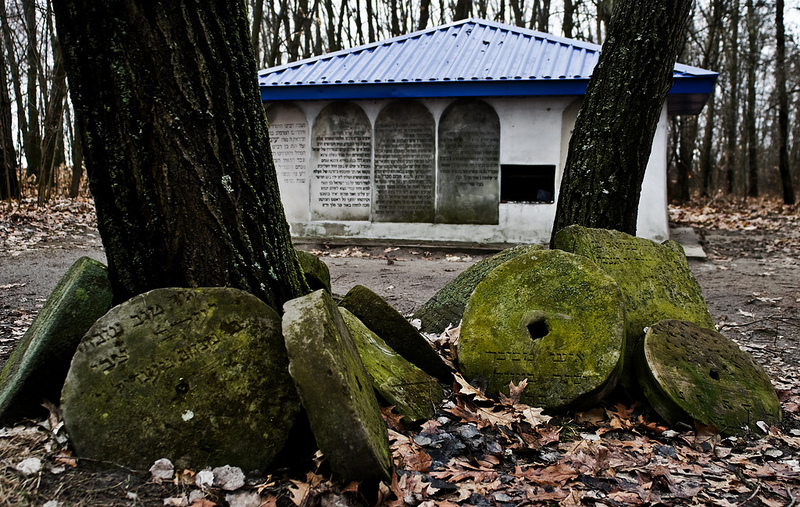Alternate names: Kock [Pol], Kotsk [Rus], Kotzk [Yid]. 51°38' N, 22°27' E, 37 miles S of Siedlce, 27 miles N of Lublin, 20 miles S of Łuków. 1900 Jewish population: 3,014. This town in E Poland about 120 km SE of Warsaw in Lublin Voivodeship in Lubartów County is the capital of the Gmina Kock with a 2004 population of 3,509. A Jewish community was established in the town in the 17th century. In the 19th century, it became an important center of Hasidism, the longtime home of Rabbi Menachem Mendel of Kotzk, the Kotzker rebbe who established the Kotsk dynasty. Most of the Jews were killed by the Nazis in the Holocaust; a Jewish community was not reestablished since the war. Several famous battles were fought there in 1809 and in 1939, the final battle of the Invasion of Poland. [June 2009]
CEMETERY:
burial list [Jan 2015]
Kock Jewish cemetery located outside the city some kilometers from its borders, only can reached via the field, a sandy path from the street called Hanka Sawicka. At the chapel, turn right. The land has a solid, metal fence with lockable gate. The keys are kept by Mr. Roman Stasiak, living in a nearby house (to the right of the cemetery), who also is caretaker of the cemetery. During WW II, the Nazis destroyed the cemetery. According to older Kock residents, the majority of the gravestones were taken to Radzyn Podlaski, where they were broken down and used for paving the streets. Some matzevot was taken by local residents and used for various purposes including as grinding wheels. In 1958, the town decided to restore the cemetery area with the help of children from local schools. Today in the cemetery are few matzevot. In the Jewish cemetery in Warsaw in cell No. 47 is the tomb of Abraham Joseph Kocka, grandson Menachem Mendel, rabbi, and since 1929 a Kock tzaddik. photos. [May 2009] For pilgrims, the most important place in the cemetery is the ohels of
- - Menachem Mendel of Kock (1787- 1859), founder of the Kock tzaddikim dynasty and teacher of Isaac Meir Rothenberg of Góra Kalwaria,
- - Beniamin Morgenstern, son of Menachem Mendel, son-in-law of Abraham Mordechaj of Góry Kalwaria, died in 1866 at the age of 26 years,
- - Dawid Morgenstern, Menachem Mendel, according to a well-known researcher of the history of Polish Jews Martin Wodzińskiego "Witty and one of the best minds of his generation," died in 1893,
- - Jakub Jozue Morgenstern, who died in 1907, son of David the tzaddik from 1906,
- - Dow Zeew ha-kohen Rappaportwho died in 1901 of Israel, son of Kohen Pińczów, son-in-law of Menachem Mendel, tzaddik.
- burial list and gravestone photos [August 2014]
Alternate name: Kotzk (Yiddish) Kock is located in Lubelskie (Lublin) at 51°39' 22°27', 40 km from Lublin. Cemetery location: 1 km NE of the market square, among the fields. Present town population is 1,000-5,000 with no Jews.
- Town: Urzad Miasta i Gminy, tel. 4.
- Regional: region Konserwator Zabytkow mgr. H. Landecka, Lublin pl. Litewski 1, tel. 290-35.
Earliest known Jewish community was mid-17th century. 1921 Jewish population was 2092 (53.6%). The town was destroyed in 1648 by Chmielnicki's army and WWII. Living here was the Hasidic dynasty of Morgenstern, 1829-1939. The Jewish cemetery was established in second half of 18th century with last Hasidic burial in 1942. The isolated rural (agricultural) flat land on a hillside has no sign, but has Jewish symbols on gate or wall. Reached by turning directly off a public road, access is open to all. A wall with a locking gate surrounds. The key is in the nearby farm. The size of the cemetery before WWII was 2.41 hectares; now it is 2.2 hectares (due to the road along the cemetery).
20-100 tombstones, less than 25% toppled or broken, date from 1818-20th century. Removed stones are incorporated into roads or structures. The granite, limestone, sandstone, and slate rough stones or boulders, finely smoothed and inscribed stones, flat stones with carved relief decoration, or double tombstones have Hebrew inscriptions. Some stones have traces of painting on their surfaces. There are unmarked mass graves. Thel Jewish community and the municipality own site used for a Jewish cemetery only. Properties adjacent are agricultural. Occasionally, organized Jewish group tours and private visitors stop. The cemetery was vandalized during and after WWII. Jewish groups abroad carried out restoration in 1988-90. The caretaker lives in a nearby farm. Within the cemetery is an ohel. Vegetation and vandalism are serious threats. The area is intensely overgrown with trees and bushes of blackthorn. Despite fencing, it is still vandalized.
Pawel Sygowski, ul. Kalinowszczyzna 64/59, 20-201 Lublin, tel. 77-20-78 completed survey. Sygowski and A. Trzcinski visited the site Dec. 1991. Interview was conducted.
REFERENCE: Gruber, Ruth Ellen. Jewish Heritage Travel A Guide to East-Central Europe. New York: John Wiley & Sons, Inc., 1992. p. 50-51
"… several tombstones. Ohel of Tzaddik Menahem Mendel Morgenstern (died 1859). [source?]
Photo courtesy of This email address is being protected from spambots. You need JavaScript enabled to view it., March 2012


